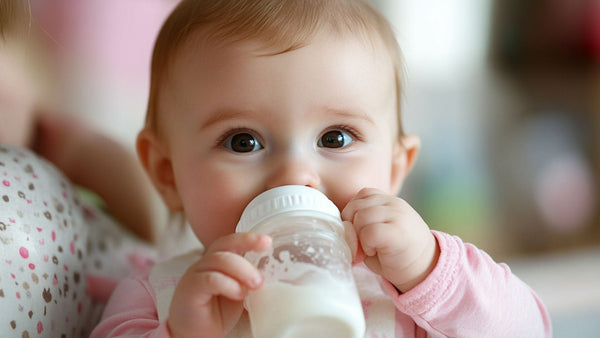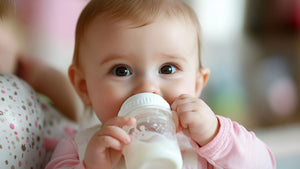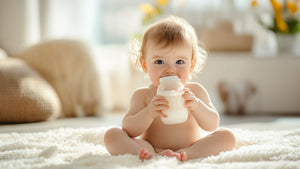Traveling Internationally with Baby Formula: TSA & Airline Rules
Flying with Baby Formula: What You Need to Know for a Stress-Free Trip
Traveling with a baby can raise many questions for parents. Parents may be concerned about how their baby will handle the flight and feeding requirements. Flying can seem complicated and raise important logistical questions. Regardless of the trip duration, parents should understand the rules of "how to travel with formula" correctly. According to TSA airline regulations, liquid formulas can exceed standard liquid limits. Airlines accommodate the nutritional needs of infants. Companies recognize the importance of formula as essential baby nutrition.
However, there are specific regulations that can be challenging for parents to navigate. A fussy baby during flight can create additional stress for parents. Understanding airline recommendations is key to minimizing any conflicts. Familiarizing yourself with current airline policies will help ensure smooth travel. Flying with baby formula can become manageable when you know the rules. Parents will learn proper techniques for mixing and warming formulas during flight. Understanding these regulations will help make the trip comfortable for both parents and baby.
Is Baby Formula Allowed on Planes? Understanding TSA & Airline Rules
Many parents wonder about baby formula when planning air travel. The common question "Can you bring formulas on a plane?" has a definitive yes answer due to TSA exemptions. Airlines permit formula transportation due to infant and toddler nutritional requirements. Formula falls under liquid restrictions but has special exceptions. The Transportation Security Administration (TSA) provides specific exemptions for baby formula. Both powder and liquid formulas are permitted for travel. Parents can carry formulas in quantities exceeding standard liquid limits. Here's what you can bring and how to pack correctly:
-
TSA baby formula powder: Dry formula has no quantity restrictions per flight. Parents should use clearly labeled containers. During security screening, you may be asked to open containers for inspection.
-
Liquid formula: Pre-mixed liquid formula is ideal for infant feeding. Liquid formula is permitted in quantities larger than the standard 3-1-1 rule. During security screening, formulas must be declared for additional testing. Parents can also bring cooling accessories for proper storage.
-
Special mixing water: Baby formula can remain unmixed during flight if preferred. Parents may bring sterilized, bottled water specifically for mixing. This water is typically allowed in carry-on luggage when declared.
-
Baby feeding items: Multiple baby bottles are permitted for formula feeding. Most international airports follow similar guidelines allowing essential baby items.
How Much Formula Can You Bring on a Plane — Domestic & International Limits

Parents need clear guidance on "how much formula can you bring on a plane?" Currently, there are no strict quantity limits for formula, depending on your baby's needs. Parents can pack formula in both checked and carry-on luggage. Rules may differ from standard liquid restrictions due to infant nutrition requirements. For flights, choose appropriate formulas with necessary nutritional components. Today, many European quality formulas like HiPP, Holle, and Kendamil offer high-quality infant nutrition. Parents should understand quantity guidelines for both carry-on and checked luggage. Here's essential information about domestic and international flight rules:
-
Parents often ask "Can I take unopened baby formula on a plane?" and the answer is yes. Liquid formula can exceed the standard 100ml limit. Powdered formula travels without quantity restrictions in appropriate containers.
-
For both domestic and international flights, parents can bring reasonable amounts of powdered formula. Special documentation is typically not required for transportation. International flight rules are generally consistent, with some regional variations.
-
For UK and EU flights, liquid formula can be brought in reasonable quantities for your baby. Security may request to inspect the formula. In Australia, both liquid and powdered formulas are permitted in reasonable quantities in carry-on luggage. Asian countries may have stricter regulations, so check specific requirements.
Traveling with Baby Formula Powder: What to Pack and How
Traveling with baby formula powder raises practical questions for parents. Air travel can present challenges in properly preparing formula for your baby. Understanding proper packing and preparation methods ensures comfortable travel. Here's what you need to know:
-
Parents can pre-portion powder into separate containers for convenience. During flight, this makes distribution and feeding much easier.
-
Many parents prefer keeping formulas in original packaging. Original containers provide the best seal and product integrity.
-
When traveling, remember to pack measuring spoons and dispensers. During flight, proper mixing tools ensure correct preparation. Insulated bags or cooling packs are essential accessories.
-
Flying with a powdered formula follows specific guidelines. Up to 350g can be safely transported without special requirements. For larger quantities, keep formula in original packaging. Security may inspect formulas in carry-on luggage. Pre-measured portions in secure containers offer the best convenience.
Best Ways to Feed Your Baby Formula In-Flight

Flying with a baby can feel overwhelming and stressful. However, specific strategies can make flights more comfortable and manageable. Feeding becomes less time-consuming with proper planning. Parents should understand how to fly baby formula during flight and feed properly. The best approaches make the process easier and more convenient. Here are important considerations:
-
Pre-prepared formulas offer the best convenience for parents. Ready-to-feed options work well with bottles or cups. For powdered formula, pre-measure portions into separate containers.
-
Parents can request flight attendant assistance for warming bottles when needed. Flight attendants can also provide hot water for mixing formulas. Monitor the warming process and water temperature carefully. Insulated bottles work best for maintaining proper temperature.
-
Traveling with baby formula becomes easier with proper feeding timing. Feed your baby during takeoff, flight, or landing phases. This process helps reduce ear pressure and altitude-related discomfort.
-
Keep necessary tools like spoons, containers, and formulas easily accessible. Having everything within reach saves time and reduces stress during feeding. For quality formula recommendations, consult with pediatric nutrition specialists. Following proper guidelines and using quality formula ensures safe, comfortable flights.
Tips and Tricks for Traveling with Baby Formula Like a Pro
Professional tips and tricks for traveling with baby formula are invaluable for smooth travel. Consider these suggestions for easier, more convenient trips. Parents following these guidelines can feed their babies easily while traveling comfortably. Here are key recommendations to simplify the flight process:
-
Pack extra portions for your baby's needs. Children may require additional feeding during longer flights. Pre-portioned formulas can go in carry-on or checked baggage as needed.
-
Label all containers clearly to simplify the process for parents and security personnel. Pre-measured containers minimize confusion during travel. Waterproof labels work best for durability.
-
Formula should be packed in insulated, temperature-controlled bags during air travel. This maintains freshness and provides proper refrigeration for later use.
-
Always have a backup plan for delays or spills. Extra formula and additional containers play important roles. Essential accessories like wipes, measuring tools, and spare baby clothes are indispensable.








Abdullah -
When I was struggling with feeding my baby on a long flight, I wish I had known about pre-measured containers and insulated bags—it would have made everything so much easier.
Kylan -
October 30, 2025
It’s really helpful to know that TSA allows baby formula in reasonable quantities even if it’s over the liquid limit, that eases a lot of travel stress for parents. I’d love to hear more about how different airlines handle warming bottles or providing hot water during long international flights!
Andrew -
September 27, 2025
We love traveling as a family, and now with baby Emilio on HiPP Dutch, I’ve learned how helpful it is that TSA and airlines make exceptions for formula—it takes a lot of stress out of flying with him.